Vue + Volo.Abp 實現Auth2.0使用者端授權模式認證
@
Volo.Abp的身份伺服器模組預設使用 IdentityServer4實現身份認證。
IdentityServer4是一個開源的OpenID Connect和OAuth 2.0框架,它實現了這些規範中的所有必需功能。
OAuth 2.0支援多種認證模式,本文主要介紹使用者端授權模式認證。使用者端授權模式流程如下圖所示:
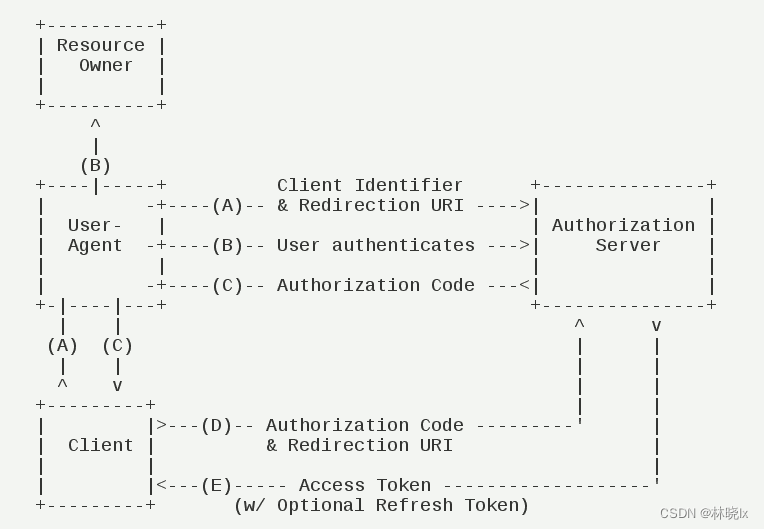
(A)使用者存取使用者端,後者將前者導向認證伺服器。
(B)使用者選擇是否給予使用者端授權。
(C)假設使用者給予授權,認證伺服器將使用者導向使用者端事先指定的"重定向URI"(redirection URI),同時附上一個授權碼。
(D)使用者端收到授權碼,附上早先的"重定向URI",向認證伺服器申請令牌。這一步是在使用者端的後臺的伺服器上完成的,對使用者不可見。
(E)認證伺服器核對了授權碼和重定向URI,確認無誤後,向用戶端傳送存取令牌(access token)和更新令牌(refresh token)。
更多關於OAuth 2.0的介紹,可以參考阮一峰的理解OAuth 2.0。
註冊Client
Client是第三方應用,它獲得資源所有者的授權後便可以去存取資源。通常第三方登入中的第三方應用就是Client。如微博登入、QQ登入等。
要使用OAuth API需要先註冊Client。通常,授權伺服器需要提供一個管理頁面,其中設定第三方應用的資訊,包括應用名稱、應用網站地址、應用簡介、應用logo、授權回撥地址等。
在本範例中,Client的註冊是通過SeedData實現的。SeedData是在應用啟動時自動執行的,它可以用來初始化資料庫,如建立初始使用者、角色、許可權、和建立Client。
使用Abp.Cli建立一個認證服務分離的專案,
在認證服務專案AuthServer中開啟appsettings.json,將vue的地址(http://localhost:8081)設定到ClientUrl和RedirectAllowedUrls
"App": {
"SelfUrl": "https://localhost:44350",
"ClientUrl": "http://localhost:8081",
"CorsOrigins": "https://*.Matoapp.com,https://localhost:44328,https://localhost:44377,http://localhost:8081,http://localhost:8082,http://localhost:8083",
"RedirectAllowedUrls": "http://localhost:8081/continue,https://localhost:44380,https://localhost:44328,https://localhost:44369"
},
專案中已經包含了一個SeedData類和一些設定,我們需要理解並修改這些設定。
我們將建立一個名為Matoapp的Client
appsettings.json設定如下
"OpenIddict": {
"Applications": {
"Matoapp_App": {
"ClientId": "Matoapp_App",
"RootUrl": "http://localhost:8081"
},
...
}
}
在OpenIddictDataSeedContributor中設定ClientType為public;
grantTypes為authorization_code和password;
scopes為該專案的服務名稱以及需要的額外userinfo資訊;
redirectUri使用者端的回撥地址。設定為http://localhost:8081/continue。
完整的CreateApplicationsAsync方法如下:
private async Task CreateApplicationsAsync()
{
var commonScopes = new List<string>
{
OpenIddictConstants.Permissions.Scopes.Address,
OpenIddictConstants.Permissions.Scopes.Email,
OpenIddictConstants.Permissions.Scopes.Phone,
OpenIddictConstants.Permissions.Scopes.Profile,
OpenIddictConstants.Permissions.Scopes.Roles,
"Matoapp",
};
var configurationSection = _configuration.GetSection("OpenIddict:Applications");
//Console Test / Angular Client
var consoleAndAngularClientId = configurationSection["Matoapp_App:ClientId"];
if (!consoleAndAngularClientId.IsNullOrWhiteSpace())
{
var consoleAndAngularClientRootUrl = configurationSection["Matoapp_App:RootUrl"]?.TrimEnd('/');
await CreateApplicationAsync(
name: consoleAndAngularClientId!,
type: OpenIddictConstants.ClientTypes.Public,
consentType: OpenIddictConstants.ConsentTypes.Implicit,
displayName: "Console Test / Angular Application",
secret: null,
grantTypes: new List<string>
{
OpenIddictConstants.GrantTypes.AuthorizationCode,
OpenIddictConstants.GrantTypes.Password,
},
scopes: commonScopes,
redirectUri: $"{consoleAndAngularClientRootUrl}/continue",
clientUri: consoleAndAngularClientRootUrl,
postLogoutRedirectUri: consoleAndAngularClientRootUrl,
permissions: new List<string> {
OpenIddictConstants.Permissions.Scopes.Roles,
OpenIddictConstants.Permissions.Scopes.Profile,
OpenIddictConstants.Permissions.Scopes.Email,
OpenIddictConstants.Permissions.Scopes.Address,
OpenIddictConstants.Permissions.Scopes.Phone,
"Matoapp",
}
);
}
...
}
Auth2.0授權
我們將使用oidc-client-ts簡化Vue中的OAuth2.0授權。有關oidc-client-ts的更多資訊,請參閱oidc-client-ts
建立一個vue專案,前端使用element-ui
安裝oidc-client-ts
yarn add oidc-client-ts
建立vue-oidc-client
建立vue-oidc-client.ts檔案,編寫程式碼如下:
// vue 2 version
import Router from 'vue-router'
import Vue from 'vue'
import {
UserManagerSettings,
Log,
User,
UserManager,
UserProfile,
WebStorageStateStore,
UserManagerEvents
} from 'oidc-client-ts'
/**
* Indicates the sign in behavior.
*/
export enum SignInType {
/**
* Uses the main browser window to do sign-in.
*/
Window,
/**
* Uses a popup window to do sign-in.
*/
Popup
}
/**
* Logging level values used by createOidcAuth().
*/
export enum LogLevel {
/**
* No logs messages.
*/
None = 0,
/**
* Only error messages.
*/
Error = 1,
/**
* Error and warning messages.
*/
Warn = 2,
/**
* Error, warning, and info messages.
*/
Info = 3,
/**
* Everything.
*/
Debug = 4
}
/**
* Creates an openid-connect auth instance.
* @param authName - short alpha-numeric name that identifies the auth instance for routing purposes.
* This is used to generate default redirect urls (slugified) and identifying routes that needs auth.
* @param defaultSignInType - the signin behavior when `signIn()` and `signOut()` are called.
* @param appUrl - url to the app using this instance for routing purposes. Something like `https://domain/app/`.
* @param oidcConfig - config object for oidc-client.
* See https://github.com/IdentityModel/oidc-client-js/wiki#configuration for details.
* @param logger - logger used by oidc-client. Defaults to console.
* @param logLevel - minimum level to log. Defaults to LogLevel.Error.
*/
export function createOidcAuth(
authName: string,
defaultSignInType: SignInType,
appUrl: string,
oidcConfig: UserManagerSettings,
) {
// arg check
if (!authName) {
throw new Error('Auth name is required.')
}
if (
defaultSignInType !== SignInType.Window &&
defaultSignInType !== SignInType.Popup
) {
throw new Error('Only window or popup are valid default signin types.')
}
if (!appUrl) {
throw new Error('App base url is required.')
}
if (!oidcConfig) {
throw new Error('No config provided to oidc auth.')
}
const nameSlug = slugify(authName)
// merge passed oidcConfig with defaults
const config = {
automaticSilentRenew: true,
userStore: new WebStorageStateStore({
store: sessionStorage
}),
...oidcConfig // everything can be overridden!
}
const mgr = new UserManager(config)
let _inited = false
const auth = new Vue({
data() {
return {
user: null as User | null,
myRouter: null as Router | null
}
},
computed: {
appUrl(): string {
return appUrl
},
authName(): string {
return authName
},
isAuthenticated(): boolean {
return !!this.user && !this.user.expired
},
accessToken(): string {
return !!this.user && !this.user.expired ? this.user.access_token : ''
},
userProfile(): UserProfile {
return !!this.user && !this.user.expired
? this.user.profile
: {
iss: '',
sub: '',
aud: '',
exp: 0,
iat: 0
}
},
events(): UserManagerEvents {
return mgr.events
}
},
methods: {
startup() {
let isCB = false // CB = callback
if (matchesPath(config.popup_redirect_uri)) {
mgr.signinPopupCallback()
isCB = true
} else if (matchesPath(config.silent_redirect_uri)) {
mgr.signinSilentCallback()
isCB = true
} else if (matchesPath(config.popup_post_logout_redirect_uri)) {
mgr.signoutPopupCallback()
isCB = true
}
if (isCB) return Promise.resolve(false)
if (_inited) {
return Promise.resolve(true)
} else {
// load user from storage
return mgr
.getUser()
.then(test => {
_inited = true
if (test && !test.expired) {
this.user = test
}
return true
})
.catch(err => {
return false
})
}
},
signIn(args?: any) {
return signInReal(defaultSignInType, args)
},
signOut(args?: any) {
if (defaultSignInType === SignInType.Popup) {
const router = this.myRouter
return mgr
.signoutPopup(args)
.then(() => {
redirectAfterSignout(router)
})
.catch(() => {
// could be window closed
redirectAfterSignout(router)
})
}
return mgr.signoutRedirect(args)
},
startSilentRenew() {
mgr.startSilentRenew()
},
stopSilentRenew() {
mgr.stopSilentRenew()
}
}
})
function signInIfNecessary() {
if (auth.myRouter) {
const current = auth.myRouter.currentRoute
if (current && current.meta.authName === authName) {
signInReal(defaultSignInType, { state: { current } })
.then(() => {
// auth.myRouter()
})
.catch(() => {
setTimeout(signInIfNecessary, 5000)
})
// window.location.reload();
// auth.myRouter.go(); //replace('/');
}
}
}
function signInReal(type: SignInType, args?: any) {
switch (type) {
case SignInType.Popup:
return mgr.signinPopup(args)
// case SignInType.Silent:
// return mgr.signinSilent(args)
}
return mgr.signinRedirect(args)
}
function redirectAfterSignout(router: Router | null) {
if (router) {
const current = router.currentRoute
if (current && current.meta.authName === authName) {
router.replace('/')
return
}
}
// window.location.reload(true);
if (appUrl) window.location.href = appUrl
}
/**
* Translates user manager events to vue events and perform default actions
* if necessary.
*/
function handleManagerEvents() {
mgr.events.addUserLoaded(user => {
auth.user = user
})
mgr.events.addUserUnloaded(() => {
auth.user = null
// redirect if on protected route (best method here?)
// signInIfNecessary()
})
mgr.events.addAccessTokenExpired(() => {
auth.user = null
signInIfNecessary()
// if (auth.isAuthenticated) {
// mgr
// .signinSilent()
// .then(() => {
// Log.debug(`${authName} auth silent signin after token expiration`)
// })
// .catch(() => {
// Log.debug(
// `${authName} auth silent signin error after token expiration`
// )
// signInIfNecessary()
// })
// }
})
mgr.events.addSilentRenewError(e => {
// TODO: need to restart renew manually?
if (auth.isAuthenticated) {
setTimeout(() => {
mgr.signinSilent()
}, 5000)
} else {
signInIfNecessary()
}
})
mgr.events.addUserSignedOut(() => {
auth.user = null
signInIfNecessary()
})
}
handleManagerEvents()
return auth
}
// general utilities
/**
* Gets the path portion of a url.
* @param url - full url
* @returns
*/
function getUrlPath(url: string) {
const a = document.createElement('a')
a.href = url
let p = a.pathname
if (p[0] !== '/') p = '/' + p
return p
}
/**
* Checks if current url's path matches given url's path.
* @param {String} testUrl - url to test against.
*/
function matchesPath(testUrl: string) {
return (
window.location.pathname.toLocaleLowerCase() ===
getUrlPath(testUrl).toLocaleLowerCase()
)
}
function slugify(str: string) {
str = str.replace(/^\s+|\s+$/g, '') // trim
str = str.toLowerCase()
// remove accents, swap ñ for n, etc
const from = 'ãàáäâẽèéëêìíïîõòóöôùúüûñç·/_,:;'
const to = 'aaaaaeeeeeiiiiooooouuuunc------'
for (let i = 0, l = from.length; i < l; i++) {
str = str.replace(new RegExp(from.charAt(i), 'g'), to.charAt(i))
}
str = str
.replace(/[^a-z0-9 -]/g, '') // remove invalid chars
.replace(/\s+/g, '-') // collapse whitespace and replace by -
.replace(/-+/g, '-') // collapse dashes
return str
}
這裡基於vue-oidc-client進行修改,因為vue-oidc-client是基於oidc-client,而oidc-client已經不再維護,所以我們使用oidc-client-ts
建立Auth2.0認證跳轉
在登入頁面login/index.vue中,新增Auth2.0認證跳轉按鈕
<el-row
type="flex"
class="row-bg"
justify="center"
:gutter="10"
>
<el-col :span="10">
<el-button
:loading="loading"
type="primary"
@click.native.prevent="handleLogin"
>
登入
</el-button>
</el-col>
<el-col :span="10">
<el-button
:loading="loading"
@click.native.prevent="handleLoginAuth2"
>
Auth2.0
</el-button>
</el-col>
</el-row>
</el-form>
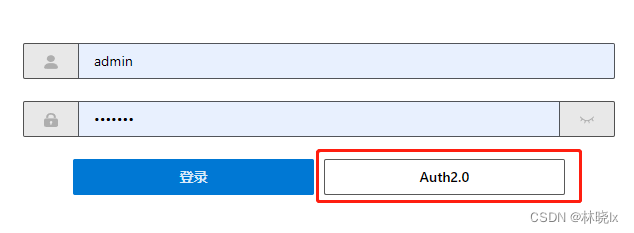
點選跳轉後,自動跳轉到認證伺服器的登入頁面
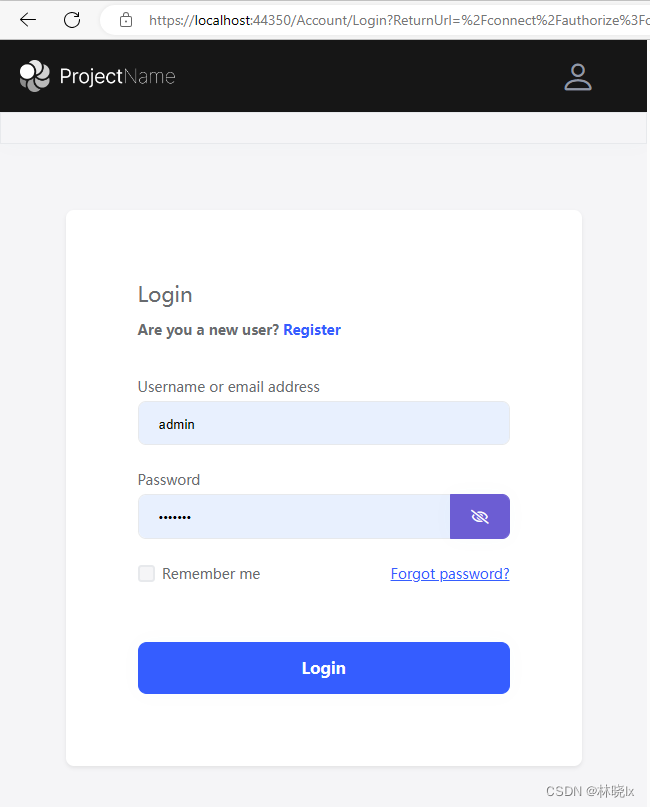
當正確輸入使用者名稱和密碼後,跳轉到使用者端的回撥地址,並攜帶授權碼code引數
環境變數中設定CLIENT_ID,資源伺服器地址和認證伺服器地址
VUE_APP_BASE_API = 'https://localhost:44377/'
VUE_APP_BASE_IDENTITY_SERVER = 'https://localhost:44350/'
VUE_APP_CLIENT_ID = 'Matoapp_App'
在login/index.vue中新增handleLoginAuth2方法
注意此處的redirect_uri要和認證伺服器中的設定一致,否則跳轉時會引發400 Bad Request
async handleLoginAuth2() {
var loco = window.location;
var appRootUrl = `${loco.protocol}//${loco.host}`;
var idsrvAuth = createOidcAuth("main", SignInType.Window, appRootUrl, {
authority: baseUrl,
client_id: "Matoapp_App", // 'implicit.shortlived',
response_type: "code",
scope: "Matoapp",
// test use
prompt: "login",
metadata: {
issuer: baseUrl,
authorization_endpoint: `${baseUrl}connect/authorize`,
end_session_endpoint: `${baseUrl}logout`,
token_endpoint: `${baseUrl}connect/token`,
},
redirect_uri: appRootUrl + "/continue",
disablePKCE: true,
});
await idsrvAuth.signIn();
}
獲取令牌
獲取完成授權碼後,需要通過授權碼獲取令牌(Token),此處將呼叫後端的介面,認證伺服器核對了授權碼和重定向URI後發放令牌
function Login(data, baseURL?: string) {
return await ajaxRequest('/connect/token', 'POST', data, "/", baseURL)
}
@Action
public async LoginByCode(codeInfo: {
code: string
redirect_uri: string
}) {
var code = codeInfo.code;
var redirect_uri = codeInfo.redirect_uri;
var data = null;
var baseUrl = process.env.VUE_APP_BASE_IDENTITY_SERVER;
await Login({
grant_type: 'authorization_code',
code: code,
client_id: process.env.VUE_APP_CLIENT_ID,
redirect_uri: redirect_uri
}, baseUrl)
.then(async (res) => {
data = res;
setToken(data.access_token);
this.SET_TOKEN(data.access_token);
return data
})
return data
}
獲取Token後將其儲存到vuex或Cookies中
建立回撥頁面
回撥頁面是在登入成功後,從回撥到登入完成的過渡頁面。
建立continue/index.vue,簡單的顯示登入成功的提示,常用的提示有「登入成功,正在為您繼續」,「登入成功,正在為您跳轉」等友好提示
<template>
<div class="login-container">
<el-result
icon="success"
title="登入成功"
subTitle="正在繼續,請稍候.."
></el-result>
</div>
</template>
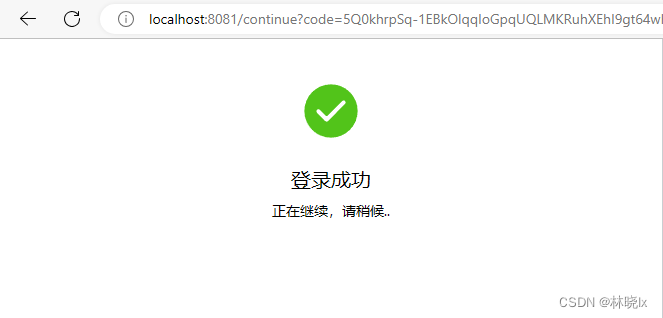
在登入成功後,會跳轉到continue頁面,回撥地址會攜帶授權碼,然後呼叫認證伺服器的connect/token介面,獲取token
建立onRouteChange函數,在此解析頁面地址中的引數
export default class extends BaseVue {
redirect?: string;
otherQuery: Dictionary<string> = {};
@Watch("$route", { immediate: true })
private async onRouteChange(route: Route) {
var loco = window.location;
var appRootUrl = `${loco.protocol}//${loco.host}`;
var query = route.query as Dictionary<string>;
if (query) {
this.redirect = query.redirect;
this.otherQuery = this.getOtherQuery(query);
if (this.otherQuery.code) {
await UserModule.LoginByCode({
code: this.otherQuery.code,
redirect_uri: appRootUrl + "/continue",
}).then(async (re) => {
GetCurrentUserInfo(baseUrl)
.then((re) => {
var result = re as any;
this.afterLoginSuccess(result);
})
.catch((err) => {
console.warn(err);
});
});
}
}
}
成功後將跳轉到首頁或者redirect指定的頁面
async afterLoginSuccess(userinfo) {
this.$router
.push({
// path: this.redirect || "/",
path: "/",
query: this.otherQuery,
})
.catch((err) => {
console.warn(err);
});
}
建立退出登入
只需要清除vuex或Cookies中的token即可,可以呼叫vue-oidc-client的signOut,但只是跳轉到設定的登出地址,不會清除token(前提是redirectAfterSignout為true,並設定了post_logout_redirect_uri)
最終效果
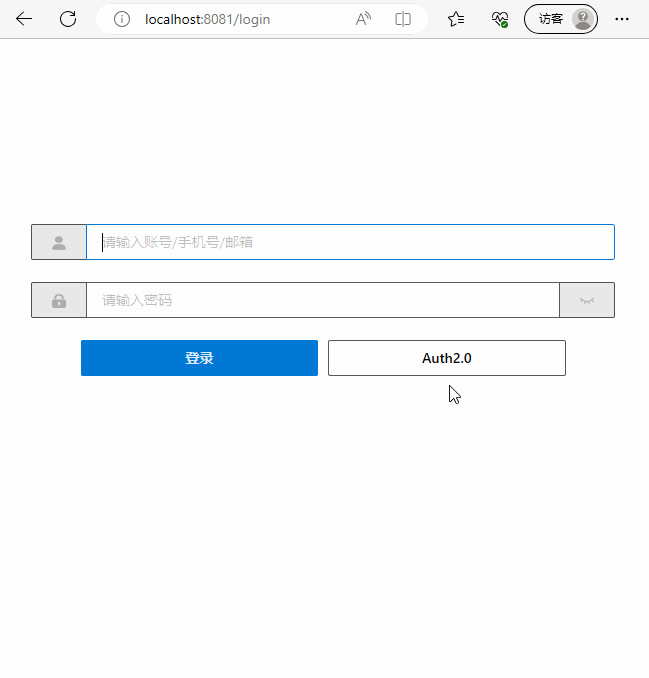
本文來自部落格園,作者:林曉lx,轉載請註明原文連結:https://www.cnblogs.com/jevonsflash/p/17534501.html